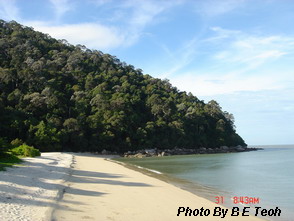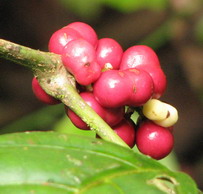|
Welcome To
PENANG NP
PAGE - PENINSULA MALAYSIA
|
History and
fact
The Penang National Park spanning 1,213ha of land and sea
awaits scientists, researchers and nature lovers to explore its
myriad of natural treasures.
Previously
known as the Pantai Acheh Forest Reserve, this pristine site
harbours a wealth of 417 flora and 143 fauna species. Pantai
Acheh Forest Reserve, located at the northwestern tip of Penang
was declared the Penang National Park in April 2003.
Penang
National Park is the first protected area legally gazetted under the
National Park Act of 1980, signifying the State and Federal
Governments’ efforts in protecting the environment.
Penang
National Park was set up to preserve and protect flora and fauna as well
as objects with geological, archaeological, historical,
ethnological and other scientific and scenic interests. The park
is unique as it contains several different types of habitat
including a meromictic lake (a lake in which some water remains
partly or wholly unmixed with the main water mass at circulation
periods), wetlands, mangroves, mudflats, coral reefs and turtle
nesting beaches.

Flora and fauna
The unique features here are five habitat types not found in
the other major Malaysian nature reserves. The park is a haven
for a wealth of 417 flora and 143 fauna species. Among the
animals spotted at the park and its surroundings are dolphins,
otters, Hawksbill turtles and monkeys.
Secondary forest is the main feature here. The beach is long
and plants are aplenty ranging from rocky bonsai to timber and
herbal plants. Trees and plants which can be found here include
Chengal, Meranti Seraya, Jelutong, Gaharu, Tongkat Ali and
Bintangor.

Disturbed
secondary forest and hardy plants such as screw pines dominate
the coast. The red paper-like bark of the pelawan trees are
abundant; undergrowth and ferns spread between the trees. Other
noticeable trees planted include casuarina trees, sea almond,
cashew nuts and the swaying coconut palms.
Several mangrove trees are found along the Tukun beach. Wild
orchids can be sighted on steep rocky slopes and cashew nuts are
common here, indicating that some agricultural activities had
taken place here many years ago. Fully-grown timber trees are
found inside the forest beyond the coast. There are also pitcher
plants (nepenthes spp), which managed to survive the coastal
habitat.

The dusky leaf monkeys and the long tailed macaque can also
be seen. Birds are aplenty, noticeable big birds like the White
Bellied Sea Eagles and the Brahminy Kites and kingfisher
occasionally can be see here.
Mammals such as wild boars, wild
cats, civet cats, sea otters, mousedeer, rats, bats and
squirrels and crabs, fishes and large prawns, monitor lizards
and snakes are common here. There is also the occasional landing
of turtles here.
Attraction and activities
Proper camping ground and amenities provided by the
authorities make camping a luxury. Bird watching should not be
missed here. The natural swimming pools provide a good place for
family outings and nature camps.
Teluk Bahang Beach
This is a
shady camping ground, and with civilization just around the
corner, it makes a suitable venue for family outings. At the
Teluk Bahang roundabout, continue straight towards the fishing
jetty and you will be able to see a restaurant called “End of
the World”. Follow trail 1A from here. This beach is easily
accessible within walking distance from the jetty and the
restaurant.
It should be
noted that Teluk Bahang is the area where the Bahang Bay is
located. It is usually confused with the Teluk Bahang township.
The panoramic fishing jetty engulfing the backdrop is a rare
sight which is built of mangrove timber and palm trunks.

Teluk Tukun
Use trail 1A-1B, and it is about 20 minutes from the End of
the World restaurant. The trail is a clear and easy walk along
the coast to reach Teluk Tukun beach. Camping grounds are built
along Tukun River. Tukun River flows into Teluk Tukun. A small
island opposite is Pulau Tukun Tengah. The national park
headquarters are situated near here. There are several small
swimming pools for campers.
Continue Page 2 >>
|